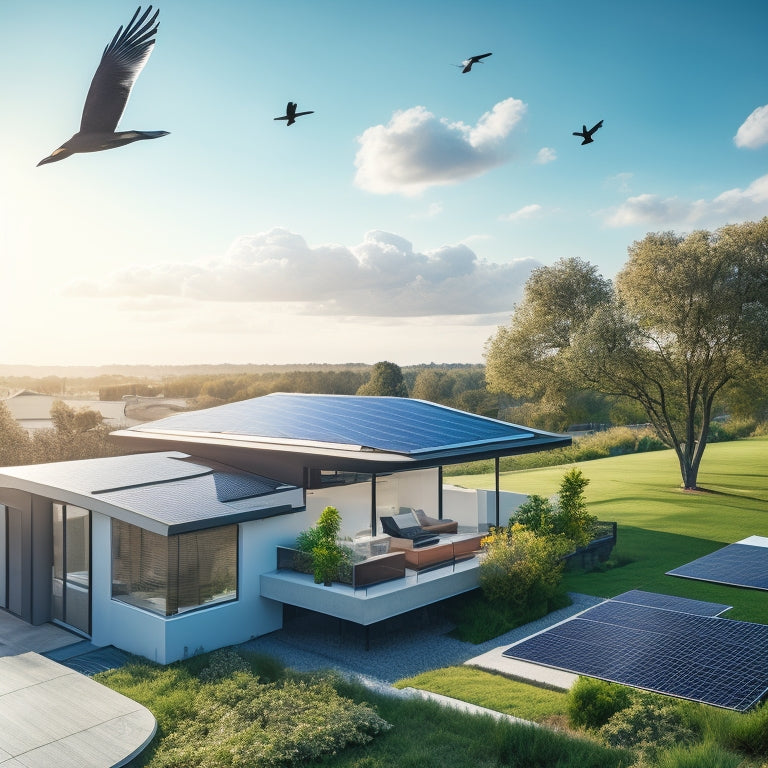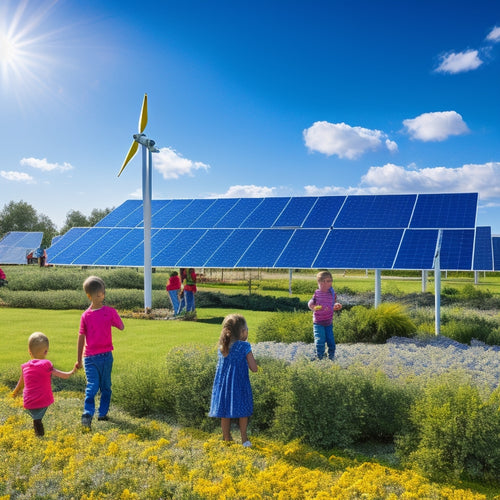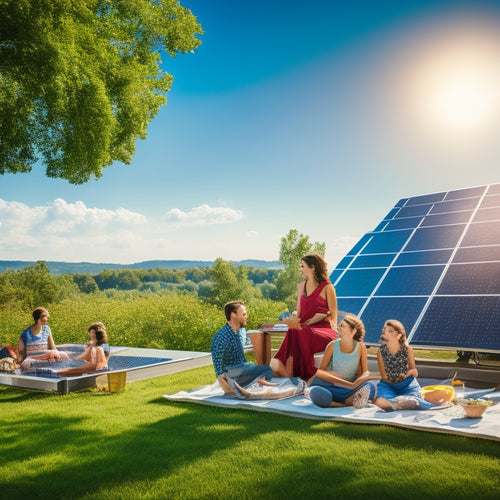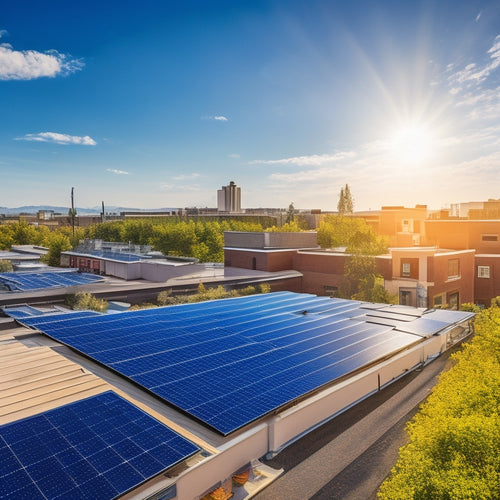
Solar Panel Buying Guide for Beginners
Share
As you start your solar panel expedition, it's important to understand your energy needs, choosing the right panel, and selecting the ideal inverter type and efficiency. You'll need to take into account panel size, configuration, and installation options that fit your space and local building codes. Budgeting is essential, factoring in upfront costs, ongoing maintenance expenses, and total cost of ownership. Researching manufacturer quality, warranties, and maintenance requirements are crucial to guarantee you're investing in a reliable system. By taking these key factors into account, you'll be well on your way to making an informed decision - and there's even more to investigate to guarantee your solar panel system meets your unique needs.
Key Takeaways
- Accurately calculate your daily energy needs in watt-hours (Wh) to determine the right system size and maximize ROI.
- Choose high-efficiency solar panels (15%-20% typical, up to 22% for top-tier panels) to ensure optimal energy production.
- Understand inverter types (string, microinverters, power optimizers) and their efficiency ratings to optimize energy output and system performance.
- Consider upfront costs, ongoing maintenance expenses, and total cost of ownership, including financing options and tax incentives, when budgeting for a solar panel system.
- Research manufacturer quality, warranties, and maintenance requirements to ensure a reliable and efficient solar panel system.
Understanding Your Energy Needs
Your energy needs serve as the foundation of your solar panel system, so it's vital to understand them accurately. To determine your energy consumption, you'll need to calculate your daily energy usage in watt-hours (Wh). Review your past electricity bills to identify your highest monthly usage, and consider factors like seasonal changes and appliance upgrades.
Next, define your solar goals: do you want to cover a portion of your energy needs or achieve complete energy independence? Be realistic about your goals, as they'll impact the size and cost of your solar panel system.
Accurately evaluating your energy consumption and setting clear solar goals will help you choose the right system size, configuration, and equipment. This, in turn, will guarantee you maximize your energy savings and ROI.
Don't underestimate the importance of this step – it's vital to getting the most out of your solar panel investment.
Choosing the Right Solar Panel
You're now ready to select the ideal solar panel for your energy needs.
When choosing the right solar panel, you'll want to take into account panel efficiency, as it directly impacts the amount of energy your system produces.
You'll also need to evaluate the size and durability of the panel to guarantee it meets your specific requirements.
Panel Efficiency Matters
Enhancing your solar panel system's overall performance hinges on selecting panels with high efficiency ratings. This metric measures how well a panel converts sunlight into electricity. High-efficiency panels can generate more power per hour of sunlight, making them ideal for small or shaded roofs.
When evaluating efficiency ratings, look for values between 15% and 20%. Top-tier solar technology can boast ratings as high as 22%. Keep in mind that higher efficiency doesn't always mean better. Balance efficiency with cost and your energy needs.
You'll often see efficiency ratings listed alongside other performance metrics like temperature coefficient and fill factor. While these specs are important, efficiency is the most critical factor in determining a panel's output.
Don't be swayed by flashy marketing claims or low prices – prioritize high-efficiency panels to get the most out of your solar investment. By selecting panels with high efficiency ratings, you'll maximize your energy production and save money on your utility bills.
Size and Durability
High-efficiency solar panels are just the starting point for a well-designed solar panel system.
You'll also need to take into account the size and durability of your solar panels to guarantee they can withstand the elements and generate power for years to come.
When it comes to size, you'll want to choose solar panels that are the right fit for your roof and energy needs. Larger panels may produce more power, but they may not be suitable for smaller roofs or residential areas with specific regulations.
Evaluate the wattage output, voltage, and current rating to ascertain you're getting the right size for your system.
Durability is also fundamental, as your solar panels will be exposed to the elements.
Look for solar panel materials that are weather-resistant and can withstand extreme temperatures, humidity, and weather conditions. A durable solar panel will maintain its performance over time, certifying you get the most out of your investment.
Be sure to check the manufacturer's warranty and certifications, such as UL and IEC, to verify your solar panels meet industry standards for weather resistance and durability.
Inverter Types and Efficiency
Choosing the correct inverter type is vital for ideal solar panel performance, as it directly influences the amount of energy you generate and feed back into the grid.
The inverter's primary function is to convert DC power from your solar panels into AC power, which is usable in your home and compatible with the grid.
When selecting an inverter, you'll encounter various inverter technologies, each with its efficiency ratings.
Here are three key types to take into account:
-
String Inverters: These are the most common type, suitable for residential installations. They're cost-effective and offer high efficiency ratings (up to 98.5%).
-
Microinverters: These small inverters are attached to individual solar panels, providing more flexibility and monitoring capabilities. They offer high efficiency ratings (up to 97%).
-
Power Optimizers: These systems combine the benefits of string and microinverters, offering high efficiency ratings (up to 98.5%) and enhanced monitoring capabilities.
Understanding inverter types and their efficiency ratings is essential for optimizing your solar panel system's performance and energy output.
Panel Size and Configuration
When it comes to maximizing energy output, every square inch of your roof matters. You'll want to optimize your panel size and configuration to generate the most power possible.
Start by considering your installation space: how much room do you have available for panels, and what're the dimensions of that space? This will help you determine the ideal panel size and number of panels you can fit.
Next, think about panel orientation. Will your panels be installed at a standard angle, or will you need to accommodate a unique roof pitch or angle? This affects not only energy output but also the structural integrity of your installation.
You'll want to choose a panel size and configuration that works harmoniously with your roof's design.
To get the most out of your system, you'll need to balance panel size with energy output. Larger panels may produce more power, but they may not be the best fit for your installation space.
On the other hand, smaller panels may be more versatile but produce less energy. By carefully considering these factors, you can create a panel configuration that maximizes your energy output and saves you money in the long run.
Mounting and Installation Options
Three key factors influence your mounting and installation options: roof type, local building codes, and personal preference.
Your roof type determines the type of mounting system you can use, with common options including asphalt shingles, metal, and tile. Local building codes dictate the installation methods and materials you can use, while your personal preference influences the aesthetic and performance aspects of your solar panel system.
When it comes to installation, you have two main options: hiring a professional installer or taking the DIY route. If you're not experienced in electrical work and roofing, it's highly advisable to hire a professional. They'll guarantee your system is installed correctly and safely.
Some popular mounting options include:
-
Roof mounts: Attached directly to your roof, these are the most common type of mounting system.
-
Ground mounts: Ideal for homes with limited roof space or obstructions, these mounts are installed on the ground.
-
Tracking mounts: These advanced mounts adjust tilt angles seasonally to maximize energy production.
Budgeting and Cost Considerations
You'll need to take into account three key cost factors when buying solar panels: upfront system costs, which include the panels, inverters, and installation; ongoing maintenance expenses, such as cleaning and repairs; and total cost of ownership, which takes into account the system's expected lifespan and energy output.
These costs will vary depending on your location, system size, and equipment choices. By understanding these costs, you can make an informed decision that meets your energy needs and budget.
Upfront System Costs
By the time you're ready to invest in a solar panel system, upfront costs are likely top of mind. This initial investment can seem intimidating, but understanding the breakdown of costs can help you make an informed choice.
The total upfront cost of a solar panel system typically includes the cost of the solar panels, inverters, mounting hardware, and installation. Additionally, you may need to evaluate permits, inspections, and connection fees.
Some key cost factors to reflect on:
-
System size and quality: A larger system with high-efficiency panels will generally cost more than a smaller system with standard panels.
-
Installation company and labor costs: Reputable installation companies with experienced laborers may charge more than smaller, less-experienced companies.
-
Financing options and tax incentives: You may be able to reduce your upfront costs through financing options or tax incentives, such as the Solar Investment Tax Credit (ITC).
Ongoing Maintenance Expenses
As you weigh the upfront costs of a solar panel system, it's equally important to contemplate the ongoing expenses associated with maintaining your system. While solar panels are relatively low-maintenance, they do require periodic cleaning to guarantee peak energy production.
You'll need to factor in the cost of cleaning methods, such as water and soap or robotic cleaning systems, to keep your panels free from debris and grime. Additionally, system monitoring is essential to identify and address any performance issues or faults. This may involve subscription-based services that provide real-time monitoring and troubleshooting.
You should also consider the cost of replacing inverters and other components that have a limited lifespan. Inverters, for instance, typically need to be replaced every 10 to 15 years.
Moreover, you may need to budget for occasional repairs or maintenance tasks, such as tightening loose connections or replacing damaged panels. By accounting for these ongoing expenses, you can guarantee your solar panel system operates at peak efficiency and provides the maximum return on investment.
Total Cost of Ownership
Throughout the lifespan of your solar panel system, various costs will accrue, and it's important to factor these expenses into your overall budget.
As you plan your solar panel investment, it's vital to take into account the total cost of ownership, which goes beyond the initial purchase price.
You'll need to account for ongoing expenses, such as maintenance, repairs, and replacement parts.
Additionally, you should evaluate the following costs:
-
Financing options: If you're not paying cash upfront, you'll need to factor in loan interest rates, fees, and repayment terms.
-
Tax incentives: While you may be eligible for federal and state tax credits, these incentives can change over time, affecting your overall savings.
-
Insurance and warranty costs: You may need to purchase insurance to protect your system from damage or theft, and warranty costs can add up over time.
Evaluating Manufacturer Quality
Your solar panel investment's success hinges on the quality of its manufacturer. A reputable manufacturer guarantees you receive high-quality products that meet industry standards. Research the manufacturer's reputation by reading reviews, asking for referrals, and checking their rating with the Better Business Bureau.
Look for manufacturers that are transparent about their production process and have a proven track record of producing efficient and durable solar panels.
Check for product certifications from reputable organizations such as UL (Underwriters Laboratories) and IEC (International Electrotechnical Commission). These certifications assure that the solar panels meet specific safety and performance standards.
You should also look for manufacturers that comply with international standards such as ISO 9001 (quality management) and ISO 14001 (environmental management). Additionally, check if the manufacturer is a member of industry associations like the Solar Energy Industries Association (SEIA) or the International Renewable Energy Agency (IRENA).
Warranties and Maintenance Requirements
When you've narrowed down your list of potential manufacturers, it's time to examine the warranties and maintenance requirements that come with their solar panels. This essential step guarantees you're protected in case something goes wrong and assures your system operates at peak performance.
Warranty terms vary between manufacturers, but you should look for a minimum of 25 years of coverage for the panels, 10 years for inverters, and 5 years for installation agreements.
Additionally, consider the following key aspects:
-
Performance guarantees: Verify the manufacturer guarantees a certain level of energy production over the panel lifespan.
-
Service contracts: Check if the manufacturer offers maintenance schedules and repair options in case of issues.
-
Replacement policies: Understand the process for replacing faulty or damaged panels, including the cost and timeline.
A thorough warranty and maintenance plan can save you thousands of dollars in the long run.
Be sure to carefully review the fine print and ask questions before making your final decision.
Frequently Asked Questions
Can I Install Solar Panels on a Metal or Tile Roof?
When installing solar panels, you'll need to take into account roof compatibility; metal roofs are generally suitable, but tile roofs may require additional installation factors, such as specialized mounting systems, to guarantee a secure and efficient energy-harvesting setup.
Are Solar Panels Affected by Shade From Trees or Buildings?
You'll find that shading impacts from trees or buildings greatly reduce solar panel efficiency, as even partial shading can decrease energy output by up to 50%; it's crucial to assess potential shade sources before installing your system.
Can I Add More Panels to My System in the Future?
You're building a solar-powered engine, and you want to know if you can add more horsepower later. Fortunately, yes, you can expand your system in the future, as long as you guarantee system compatibility and plan for future expansion upfront.
Do Solar Panels Produce Electricity During Power Outages?
When the grid goes down, you'll still have power if you've invested in off-grid systems with battery storage; however, you won't get electricity directly from your solar panels during a blackout without this setup, so plan accordingly.
Can I Use Solar Panels to Charge My Electric Vehicle?
You can charge your electric vehicle using solar panels, but you'll need to guarantee EV compatibility and a sufficient solar charging system, considering factors like panel size, inverter capacity, and charging speed to efficiently power your ride.
Conclusion
As you commence your solar panel expedition, it's no coincidence that you're taking the first step towards utilizing the power of the sun. You've now got the knowledge to choose the perfect panel, inverter, and mounting system for your unique energy needs. By factoring in budget, manufacturer quality, and warranties, you'll be well on your way to saving money and reducing your carbon footprint. Coincidentally, you'll also be joining the ranks of savvy homeowners who've made the smart switch to renewable energy.
Related Posts
-

Solar Power for Community Energy Independence
Solar power is essential for your community's energy independence, offering both environmental and economic benefits....
-

Solar Power Savings for Environmentally Aware Consumers
Switching to solar power lets you drastically cut your carbon footprint while saving money in the long run. Each kilo...
-

Solar Energy Solutions for Small Businesses
Switching to solar energy can be a game changer for your small business. You'll enjoy significant cost savings on mon...


